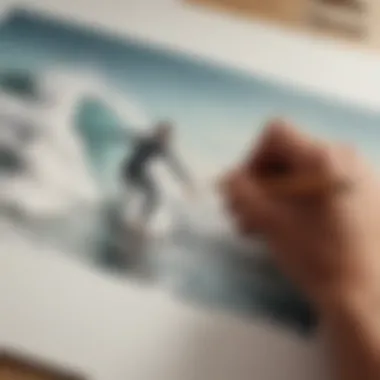Exploring Vintage Surf Posters and Their Cultural Impact
Intro
Vintage surf posters are more than mere visual artifacts; they embody a lifestyle and a culture that has captured the hearts of surf enthusiasts for decades. These posters often depict breathtaking ocean waves, athletic surfers, and idyllic beach scenes, all wrapped in the vibrant colors and artistic styles reflective of their time. The allure of vintage surf posters stretches far beyond their aesthetic appeal; they serve as a snapshot of surfing history and the rich tapestry of culture surrounding it.
As we meander through this intricate landscape, we'll explore the origins, artistic evolution, and cultural significance of these captivating pieces. They didn’t just decorate walls – they stirred passions, inspired generations, and carved out a unique niche within both the surfing community and the broader art world. With the rise of interest in unique, historical artifacts, the market for these posters has also burgeoned, becoming an avenue for collectors and enthusiasts to invest in a slice of surf lore.
Certain elements will guide our journey, including the artistic traits that define the genre, the shifting tides of design trends over the years, and the factors that add to their collectibility today. It's an exploration that appeals not only to collectors but to anyone with a love for surfing, art, or the stories behind how culture evolves.
"A vintage surf poster captures the spirit of adventure and the bond between humans and the ocean, reminding us of the magic behind the waves."
Prepared to dive deep into this world of color, nostalgia, and artistry? Let’s paddle out together.
Preamble to Vintage Surf Posters
The vibrant and soulful world of vintage surf posters acts as a window into a culture defined by waves, adventure, and a strong sense of community. These posters do not merely exist as decorative art; they encapsulate an entire ethos that resonates with surfers and enthusiasts alike. As a vehicle for expression, they capture the spirit of surfing's evolution and the era from which they hail. Understanding vintage surf posters is crucial as it offers insight into a significant cultural movement that has transcended generations.
When we talk about vintage surf posters, it is not just about the art displayed on paper. It is about the stories they tell—the legends they immortalize, the surf spots they promote, and the very heart and soul of a lifestyle.
Defining Vintage Surf Posters
To grasp the true essence of vintage surf posters, it’s essential to define what they represent. Generally, we categorize a surf poster as vintage if it originates from the mid-20th century to the late 1970s. This timeframe is pivotal as it marks the rise of surf culture thanks in part to the surf movie boom and the advent of surf brands. The artworks frequently include colorful depictions of surfers riding the waves, idyllic beach scenes, catchy slogans, and alluring travel destinations—offering not merely a visual but an aspirational experience.
The artistic style of these posters often reflects a whimsical and carefree approach to life, distinguished by vibrant hues and exaggerated figures. Artists such as John Van Hamersveld and Rick Griffin played crucial roles, incorporating psychedelic colors and surreal imagery that mirrored the cultural shifts of their time. This style spoke directly to a generation that sought freedom and adventure, igniting interest in surf culture and lifestyle beyond the waves.
Historical Significance in Surf Culture
Vintage surf posters hold a vital position within surf history. They captured the essence of the surf revival from post-World War II when returning veterans brought back new perspectives of leisure and enjoyment of the coastlines to America. These artists weren't just creating art for art's sake; they were forming a cultural narrative. The imagery conveyed through these posters often encouraged tourism to surf spots like California's Malibu or Hawaii’s North Shore, fostering a community that would shape the landscape of modern surfing.
Beyond the personal and communal aspects, vintage surf posters also reflect broader historical contexts. The evolution from surfing's outsider status to mainstream popularity is evident in the shifting styles and themes of the artwork. This metamorphosis highlights societal changes during the 1960s and 1970s, where surfing became not just a sport, but a lifestyle and ingrained cultural phenomenon.
"The surf poster is inherently a bridge between art and culture, encapsulating not just waves, but a way of life full of freedom and adventure."
Artistic Characteristics
The charm of vintage surf posters lies not just in their nostalgic allure but also in their intricate artistic characteristics. These elements serve as the very backbone of the posters, weaving together style, message, and culture. Without delving into these design features, one could easily overlook the significance they hold in representing surf culture. Let's explore how design, color, and typography contribute to the impact of these visual artifacts.
Design Elements and Aesthetics
When one thinks about surf culture, the first thing that comes to mind might be the ocean waves or sandy beaches. However, the design elements encapsulated in vintage surf posters transform these thoughts into something visually compelling.
Each poster is marked by an experimental knack for creativity, often merging traditional artistic techniques with contemporary design practices. Curvilinear forms and exaggerated perspectives are common; they mimic the fluidity of water and the vibrant energy of surfing. Design components are not merely decorative; they underscore emotion, movement, and the adrenaline that come with gliding on waves.
Additionally, the aesthetics often reflect cultural themes that resonate with the surfer's lifestyle—think of scenes depicting sunset skies, carefree beachgoers, or bold surfboards. These visuals are more than eye candy; they're instant invitations to experience the joy of surfing.
Color Schemes and Imagery
Color plays a pivotal role in the narrative that vintage surf posters convey. Saturated hues such as turquoise, sunset orange, and vibrant yellows not only draw attention but also evoke the feelings of warmth and freedom associated with surfing. These colors manage to capture the essence of summer, sun, and sea, making them unforgettable.
Images often showcase surfers in dynamic poses against expansive ocean backdrops. This imagery serves two purposes: it not only illustrates the sport but also captures the spirit of adventure.


A well-chosen color scheme can significantly influence the emotional impact of a poster. For example:
- Cool colors like blues and greens can evoke calmness and relaxation, reflecting the tranquility of ocean waves.
- Warm colors like reds and yellows breathe vitality and excitement, appealing to the thrill-seeker.
Ultimately, the choice of color and imagery creates an authentic sense of place, which is crucial for those who are deeply rooted in surf culture.
Typography and Iconography
Another layer of artistry in vintage surf posters can be found in the typography and iconography employed in their design. Bold, stylized fonts often take center stage, showcasing the carefree spirit of surfing. They might reflect a playful or rebellious attitude, tailored to match the overall aesthetic of the artwork.
Iconography includes symbols integral to the surfing experience. Items such as surfboards, waves, and palm trees often become repeating motifs designed to resonate with the viewer's love for the sport. The careful selection of fonts and images can tell a story, bridging the gap between art and culture.
"Typography in vintage surf posters conveys not only information but emotions. It breathes life into the visuals, creating a personal connection with the audience."
Understanding these artistic characteristics of vintage surf posters is essential. They are more than just colorful prints; they're historical documents, vivid storytellers, and cultural markers within the surfing community. This synthesis of design, color, and typography makes these posters a unique form of art that continues to resonate with collectors and enthusiasts today.
Evolution of Surf Posters
The journey of surf posters reflects a fascinating blend of culture, art, and social change. As we trace their evolution, we see how they not only depict surf culture but also symbolize the societal shifts of their times. Surf posters, particularly vintage ones, encapsulate a spirit that transcends mere representation; they tell stories of rebellion, freedom, and connection to nature. Understanding this evolution is key for both collectors and enthusiasts—offering a window into the values and aesthetics that have shaped the surfing world.
The Early Years: Post-War Influence
In the aftermath of World War II, America was brimming with optimism. The late 1940s marked the beginning of a new era, where surf culture began to manifest in ways that were previously unimaginable. With the return of soldiers, life resumed, and recreational activities climbed to new heights. Beach towns blossomed, and with them, the need for visual promotion became apparent.
During these early years, surf posters became a vital means of advertising local surf spots, contests, and commercial products related to surfing. The designs often featured bold colors and playful imagery, capturing the essence of the carefree beach lifestyle. Some notable artists, like John Van Hamersveld, contributed significantly to this period with works that showcased surfers riding waves against breathtaking backdrops. The posters racaputred a sense of freedom and adventure that resonated with a generation moving away from the shadows of war.
"These early surf posters weren’t just advertising; they were the first brush strokes painting the canvas of surf culture."
The 1960s: Rise of the Surf Culture
The 1960s heralded a golden age for surf posters, coinciding with the explosion of surf culture into mainstream media. This decade was not just an offshoot of the previous, but rather a radical transformation. Films like Endless Summer showcased the thrill of surfing, leading to a heightened interest in the sport. Artists such as Rick Griffin and John Van Hamersveld dove deeper into creative expression, designing posters that challenged traditional norms.
The vibrant art style from this era was marked by intricate work and psychedelic themes, paralleling the wider countercultural movements of the 1960s. The imagery became not only visually striking but also politically and socially relevant. It spoke to the youth’s desire to break free from conformity and explore new horizons. Posters from this time served as rallying cries, symbolizing freedom and the quest for adventure. The colorful waves and energetic surfers captured a vibrant lifestyle that resonated deeply, making them sought-after pieces of art in their own right.
Modern Interpretations and Revivals
As we moved into the 21st century, the appreciation for vintage surf posters began to undergo a revival. This reinvigoration can be attributed to several elements, including the resurgence of interest in retro aesthetics and the increasing popularity of sustainable and artisanal movements. Modern artists began to draw inspiration from the classic designs of the past, blending old-school techniques with contemporary technology and styles.
Now, surfers, collectors, and decorators alike often seek out vintage surf posters to integrate into modern design sensibilities. They can be found stretched across the walls of coffee shops, surf stores, and beach houses, serving as both conversation starters and nostalgic pieces of art.
The symbiotic relationship between surfing culture and art continues to evolve, with many artists experimenting with various materials and mediums. This modern interpretation aims not only to honor the traditional styles but also to question their relevance in today's fast-paced society.
In summary, the evolution of surf posters from the post-war era to today illustrates a continuous dialogue between art and culture. Each phase has added layers to their significance, marking them not just as pieces of nostalgia but as important cultural artifacts.
Influential Artists and Designers
When it comes to vintage surf posters, the artists and designers behind these captivating images play a pivotal role in shaping the culture and aesthetics of the surfing world. Their influence stretches beyond mere decoration; these creatives contributed to defining a lifestyle, providing not just visual appeal but also narratives that resonate with the water-loving community.
Notable Figures in Surf Art


The surf poster scene, rich in its assortment of artists, features several notable figures whose works stand the test of time. One such name is John Van Hamersveld, a California-based artist known for his iconic designs, like the famous Endless Summer poster. He cleverly combines bold colors and dynamic imagery that encapsulate the invigorating spirit of surfing. His graphics capture the essence of an era and have become synonymous with surf culture.
Another significant contributor is Rick Griffin, whose psychedelic style brought a unique twist to surf posters in the 1960s. Griffin's artwork didn't just attract surfers; it bled into the realms of music and counterculture, reflecting the vibe of the times. His vibrant, intricate designs portrayed surfers navigating massive waves, making his work resonate deeply with fans both in and out of the water.
Among other names, we can't overlook the influence of Tom Whalen, an artist who infuses his work with a modern take on retro aesthetics. Utilizing a minimalist approach, his posters evoke a nostalgic feel while also appealing to today’s sensibilities. Each piece serves as more than just a poster; it's a visual statement that reflects contemporary trends while honoring the rich history of surf art.
"Every poster tells a story, a glimpse into the heart of surf culture. It's not just art; it's a movement."
The Role of Billabong and Other Brands
Brands like Billabong have played a fundamental role in promoting and disseminating retro surf art. The company's commitment to surf culture is evident in their marketing strategies, where they frequently incorporate vintage-inspired designs into their products. By collaborating with artists who specialize in surf aesthetics, they ensure that these designs not only beautify their merchandise but also honor the legacy of surf art.
Moreover, businesses such as Quiksilver and O'Neill contribute to this artistic landscape by producing apparel and accessories that feature distinctive surfing themes. Their promotional materials often incorporate classic surf poster designs, which not only captivates longtime fans but also introduces new audiences to the magic of vintage surf art.
In summary, the artists and brands behind vintage surf posters have a profound impact on the culture of surfing. Their work not only preserves the memory of surf history but also keeps it alive and pertinent to current and future generations of surfers. The nostalgia these posters evoke is intertwined with the ride and thrill of catching waves, making them a cherished element in the surf community.
Cultural Impact Beyond Surfing
The reach of vintage surf posters extends far beyond the shores and waves they celebrate. They reflect a vibrant culture, intertwining with various aspects of society, art, and style. Through their vibrant imagery and meaningful messages, these posters have molded not just the surf community but have left an indelible mark on popular culture.
Influence on Popular Culture
Vintage surf posters have been a solid foundation for various forms of artistic expression. When you look at the vibrant scenes of surfers riding waves or lounging under palm trees, these posters encapsulate an escapism that people crave. They inspired musicians, filmmakers, and artists to incorporate elements of surf culture into their works.
For instance, the music of the Beach Boys or the film "The Endless Summer" embraces the laid-back, adventurous spirit that defines surfing. It's almost as if the posters serve as a visual language that speaks to the heart of that independent lifestyle, influencing countless artistic endeavors. Popular culture often borrows themes from these posters, turning their nostalgic depictions into something fresh and relevant today.
"Surfing is more than a sport; it's a statement. It's about freedom, thrill, and an unfiltered connection to the ocean."
Anonymous
Integration into Fashion and Lifestyle
Moreover, vintage surf posters have seamlessly blended into fashion and lifestyle concepts. Clothing brands frequently draw inspiration from the colorful graphics and themes of surf posters to evoke a carefree aesthetic. Think of brands like Quiksilver and Roxy, which integrate those retro designs into their collections. They're not just selling clothes; they’re peddling a lifestyle that resonates with adventure and the ocean.
Furthermore, home décor has seen a wave of transformation, embracing the relaxed vibes of surfing. Vintage posters find their way into homes, cafés, and even workplaces, creating an atmosphere infused with history and adventure. The visual allure of these prints lends itself to interior design, allowing individuals to express their passion for not just surfing but an overall lifestyle rooted in freedom and creativity.
In summary, the cultural impact of vintage surf posters transcends the water. They influence music, film, fashion, and even home aesthetics. By embodying the spirit of the surfing life they instill a sense of nostalgia, adventure, and creativity that captivates audiences across the globe, enriching both coastal and urban lifestyles alike.
Market for Vintage Surf Posters
The world of vintage surf posters presents a fascinating intersection of art, culture, and commerce. This market is not merely about buying and selling but also involves understanding the narratives and memories captured in each design. Collecting these posters offers deeper insights into surf culture, as well as historical contexts that an enthusiast may appreciate.
Many potential buyers may not realize the sheer diversity of styles and artists that characterize this niche market. From the early days of post-war posters to contemporary revivals, each piece tells a story and holds significance that extends beyond its visual appeal. Collecting vintage surf posters has become an exciting endeavor for seasoned collectors and newcomers alike, each hoping to discover the rare gem that resonates with their personal journey.
Collectors’ Trends and Insights
The enthusiasm for vintage surf art has skyrocketed, drawing in collectors who share a zeal for surfing and aesthetic appeal. Here are several trends shaping this dynamic community:
- Diverse Market Demographics: Age and background vary widely among collectors. Younger surf enthusiasts often look towards the nostalgic designs of the '60s, while older individuals may seek iconic pieces that connect them to their past.
- Online Platforms: The rise of sites like Reddit and Facebook groups has led to increased visibility. Enthusiasts exchange information, showcase new finds, and assist others in tracking down specific pieces.
- Collaborations with Artists: Some surf brands collaborate with contemporary artists, creating limited-edition posters that attract serious collectors. The blend of modern artistry with classic surf themes creates a unique product that appeals to various aesthetics.


The overarching theme in this space is a profound appreciation for the artistic expression that surf culture embodies. Collectors often connect with the stories behind the artists and the events they depict.
Factors Affecting Value and Rarity
When it comes to pricing and determining the value of vintage surf posters, several elements play a significant role:
- Age and Provenance: The oldest posters, especially those from the post-war era, are considered more valuable. Proof of authenticity and origins can significantly enhance the price.
- Condition and Preservation: Posters in good condition naturally fetch a higher price. Signs of wear and tear, fading, or water damage can dramatically reduce value. Consequently, taking care of the pieces using best practices can positively influence their longevity and worth.
- Artist Recognition: The fame and reputation of the artist can bump up a poster’s market value considerably. Well-known surf artists like John Van Hamersveld or Rick Griffin appeal to fans both for their artistry and cultural significance.
- Cultural Resonance: Some pieces resonate more with collectors due to their affiliations with iconic events or surfing legends. For instance, any poster linked to significant surf contests tends to be highly coveted.
In the ever-evolving market, understanding these factors can empower collectors and aid them in making informed decisions about purchases and investments.
"Collecting vintage surf posters is like holding a piece of the ocean's soul. Each design is a wave from the past, crashing into present memories.”
Navigating this market not only requires knowledge but also a sincere passion for the art and culture it represents.
Preservation and Restoration
The world of vintage surf posters is a testament to both artistic creativity and the vibrant surf culture that flourished particularly in the mid-20th century. As with any valuable artifacts, the preservation and restoration of these posters is crucial. It ensures that future generations can appreciate the aesthetic and cultural significance encapsulated in each piece. The aging process can be harsh on paper products, with factors like light exposure, humidity, and improper handling leading to deterioration. Therefore, understanding the best practices for preservation, alongside professional restoration techniques, becomes vital for collectors and enthusiasts alike.
Best Practices for Preservation
Preserving vintage surf posters requires both care and knowledge. Here are some effective practices:
- Storage Conditions: Keep posters in a controlled environment. Ideally, a cool, dry place away from sunlight is best. It can be wise to store them in acid-free sleeves or archival boxes to prevent contact with deteriorating materials.
- Handling Procedures: Always wash your hands before handling posters. Oils and dirt from our fingers can contribute to degradation. Using cotton gloves is a smart choice when touching the surface.
- Display Tips: If you want to showcase your favorites, consider using UV protective glass in frames to shield them from harmful light. Additionally, hanging them at a distance from heat sources will protect the paper from warping or cracking.
- Regular Monitoring: Keep an eye on the condition of your collection. Look for signs of wear and tear, such as discoloration or fading. Catching these issues early can make a substantial difference.
Professional Restoration Techniques
Sometimes, despite your best efforts, a vintage surf poster might require professional intervention. Here's what to consider:
- Assessing Damage: Initial evaluation by a conservator is crucial. They can determine the extent of damage and suggest an appropriate course of action, whether that’s cleaning or more extensive restoration.
- Cleaning Methods: Experts might utilize specialized tools and techniques, such as smoke sponge cleaning or dry brushing, to remove surface dirt without damaging the paper.
- Tears and Creases: For small tears or creases, professionals often use archival tape that doesn’t compromise the integrity of the original piece. If necessary, they might employ Japanese paper for mending tears, due to its strength and compatibility with various types of paper.
- Color Restoration: In cases where vibrant images have faded, skilled restorers can carefully add color using archival pigments that adhere to conservation principles.
"Preservation isn’t just about saving a piece of paper; it’s about keeping alive the stories and culture behind it."
In summary, the preservation and restoration of vintage surf posters are fundamental to safeguarding surf history. Implementing best practices can extend the life of these posters, while professional techniques can breathe new life into worn pieces. By making preservation a priority, we can sustain the legacy of these vibrant artworks for generations to come.
The End and Future Directions
The exploration of vintage surf posters reveals much more than just colorful artworks from bygone eras. They symbolize a unique intersection of art and lifestyle, encapsulating the essence of surfing culture with every brushstroke. As we look ahead, it is essential to examine both the enduring legacy these posters have created and the emerging trends shaping their future.
The Enduring Legacy of Surf Posters
Vintage surf posters are not just nostalgic relics; they are venerated artifacts that continue to inspire current generations. Each poster tells a story—whether it’s a promo for surf competitions, cruising along a beach, or even community gatherings that revolve around the surfing lifestyle. Their visual language speaks to the freedom of the ocean, the thrill of the wave, and the camaraderie that surfing brings. Over the years, many iconic artists, like John Van Hamersveld and Rick Griffin, have imprinted themselves in the surf art scene, leaving behind a trove of works that hipsters and traditionalists alike celebrate.
This legacy is also preserved through collections in galleries and museums dedicated to surf history. Members of the overarching surf community endeavor to celebrate this rich visual past, ensuring that these unique pieces remain part of the conversation. As surf culture continues to evolve, contemporaries draw from these historical wellsprings, resulting in a fusion of styles and techniques which honors past artists while pushing the boundaries of contemporary designs. Vintage posters have encouraged an art form that integrates influences from pop culture, local history, and commercial enterprise, gesturing towards a broader appreciation for visual culture.
"In the surf world, nostalgia acts like an anchor, holding tightly to moments that define us while allowing the tide of new influences to flow over."
Looking Forward: New Trends and Challenges
The future of vintage surf posters signifies both opportunities and challenges. As we embrace digital art and online platforms, the essence of poster art is also undergoing a metamorphosis. Artists are experimenting with techniques like augmented reality and interactive optics, which can transform viewing into an immersive experience.
However, the challenge lies in preserving the authenticity and charm that vintage art offers. The market saturation of high-quality reproductions blurs the lines between original works and facsimiles, affecting collectors and artists alike. It’s pertinent for collectors to hone their knowledge, discern quality pieces, and foster connections within the community.
Another factor to consider is the sustainability of materials used in production. As eco-friendliness becomes a priority in art and design, artists must balance tradition with innovation. Finding ways to incorporate sustainable practices without compromising aesthetic integrity will prove crucial as the market shifts.
In addition, the continuing rise of social media presents an interesting dynamic, where fresh trends can spring up overnight. Platforms like Instagram have invigorated the surf community, bringing forth a new generation of artists and collectors who view vintage surf posters not just as art, but as lifestyle statements. This intersection elevates the posters into arenas previously uncharted, finding their way into modern homes and digital lives, while still maintaining ties to their rich history.
As we delve into these future directions, the commitment to honoring the enduring legacy of surf posters remains at the forefront. Continuing to explore this ever-changing landscape will invite further appreciation for the profound impact these artworks hold within the surf culture.















